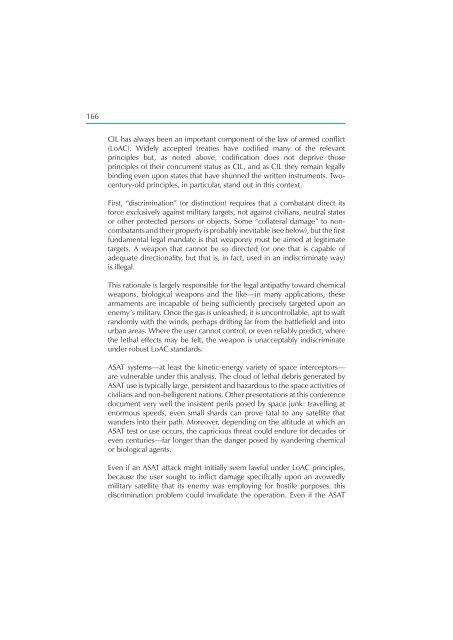Security in Space The Next Generation - UNIDIR
Security in Space The Next Generation - UNIDIR
Security in Space The Next Generation - UNIDIR
Create successful ePaper yourself
Turn your PDF publications into a flip-book with our unique Google optimized e-Paper software.
166<br />
CIL has always been an important component of the law of armed confl ict<br />
(LoAC). Widely accepted treaties have codifi ed many of the relevant<br />
pr<strong>in</strong>ciples but, as noted above, codifi cation does not deprive those<br />
pr<strong>in</strong>ciples of their concurrent status as CIL, and as CIL they rema<strong>in</strong> legally<br />
b<strong>in</strong>d<strong>in</strong>g even upon states that have shunned the written <strong>in</strong>struments. Twocentury-old<br />
pr<strong>in</strong>ciples, <strong>in</strong> particular, stand out <strong>in</strong> this context.<br />
First, “discrim<strong>in</strong>ation” (or dist<strong>in</strong>ction) requires that a combatant direct its<br />
force exclusively aga<strong>in</strong>st military targets, not aga<strong>in</strong>st civilians, neutral states<br />
or other protected persons or objects. Some “collateral damage” to noncombatants<br />
and their property is probably <strong>in</strong>evitable (see below), but the fi rst<br />
fundamental legal mandate is that weaponry must be aimed at legitimate<br />
targets. A weapon that cannot be so directed (or one that is capable of<br />
adequate directionality, but that is, <strong>in</strong> fact, used <strong>in</strong> an <strong>in</strong>discrim<strong>in</strong>ate way)<br />
is illegal.<br />
This rationale is largely responsible for the legal antipathy toward chemical<br />
weapons, biological weapons and the like—<strong>in</strong> many applications, these<br />
armaments are <strong>in</strong>capable of be<strong>in</strong>g suffi ciently precisely targeted upon an<br />
enemy’s military. Once the gas is unleashed, it is uncontrollable, apt to waft<br />
randomly with the w<strong>in</strong>ds, perhaps drift<strong>in</strong>g far from the battlefi eld and <strong>in</strong>to<br />
urban areas. Where the user cannot control, or even reliably predict, where<br />
the lethal effects may be felt, the weapon is unacceptably <strong>in</strong>discrim<strong>in</strong>ate<br />
under robust LoAC standards.<br />
ASAT systems—at least the k<strong>in</strong>etic-energy variety of space <strong>in</strong>terceptors—<br />
are vulnerable under this analysis. <strong>The</strong> cloud of lethal debris generated by<br />
ASAT use is typically large, persistent and hazardous to the space activities of<br />
civilians and non-belligerent nations. Other presentations at this conference<br />
document very well the <strong>in</strong>sistent perils posed by space junk: travell<strong>in</strong>g at<br />
enormous speeds, even small shards can prove fatal to any satellite that<br />
wanders <strong>in</strong>to their path. Moreover, depend<strong>in</strong>g on the altitude at which an<br />
ASAT test or use occurs, the capricious threat could endure for decades or<br />
even centuries—far longer than the danger posed by wander<strong>in</strong>g chemical<br />
or biological agents.<br />
Even if an ASAT attack might <strong>in</strong>itially seem lawful under LoAC pr<strong>in</strong>ciples,<br />
because the user sought to <strong>in</strong>fl ict damage specifi cally upon an avowedly<br />
military satellite that its enemy was employ<strong>in</strong>g for hostile purposes, this<br />
discrim<strong>in</strong>ation problem could <strong>in</strong>validate the operation. Even if the ASAT








